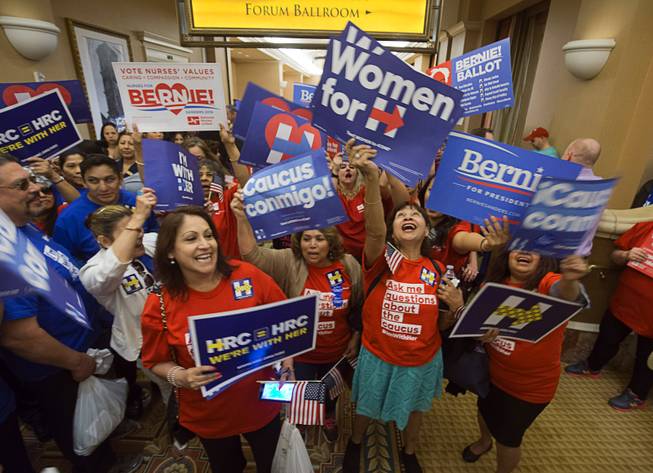
Supporters of Hillary Clinton and Bernie Sanders hold up signs outside the caucus site Saturday, Feb. 20, 2016, at Caesars Palace.
Monday, Feb. 29, 2016 | 2 a.m.
With Nevada caucuses behind them, Hillary Clinton and Donald Trump — the two clear victors in the state — have turned their attention to Super Tuesday, the biggest single day for presidential candidates to receive delegates. Residents of 12 states and one U.S. territory will vote March 1 to decide 595 Republican delegates and 1,004 Democratic delegates. The Republicans need 1,237 delegates to win the party’s nomination. The Democrats, 2,383.
In case you missed the political fever sweeping Nevada over the past couple of weeks, here’s recap of what happened and what it means for the presidential candidates moving forward.
5 takeaways for Democrats
• A close but decisive win for Clinton: Clinton didn’t win by the 23-point landslide that once was projected. Nevertheless, she had a decisive victory here, winning 53 percent of the state delegates versus Sanders’ 47 percent. That translates to 20 delegates for Clinton and 15 delegates for Sanders when they reach the Democratic National Convention in July.
The win boded well for Clinton heading into South Carolina’s primary, where polls placed her about 24 points ahead of Sanders.
“She has got to be feeling good,” UNLV political science professor David Damore said. “She’s going to do well, presumably with back-to-back wins.”
The big question for Sanders will be: Can he expand his appeal to Super Tuesday states?
“He’s not going to have the luxury of competing in small states, where you can bring in thousands of troops,” Damore said. “It’s a different kind of animal.”
• Clinton’s strength on the Strip: In the last week before the Nevada caucuses, Clinton spent significant time back-of-house on the Strip, visiting with workers. That showed on caucus day, when Clinton won all six at-large precincts on the Strip.
Clinton built a relationship with those workers, many of whom are members of the powerful Culinary Union, during the 2008 election when she competed against then-Sen. Barack Obama. Many of those workers, interviewed by the Sun, remembered her from her 2008 campaign, had voted for her then and voted for her again this year.
• Sanders performs well in Washoe and rural counties: While Clinton dominated in urban Clark County, capturing 55 percent of the votes, Sanders fared better in Washoe County and the rurals. He received 54 percent of the vote in Washoe, where he spent a whole day campaigning the weekend before the caucuses.
He also fared better than Clinton in Elko, even though both candidates made stops there on their campaign trips through the state. Sanders received 57 percent of support there.
Churchill County was the only county equally split between Sanders and Clinton, with exactly 50 percent of delegates going to each candidate.
• Clinton and Sanders vie for the Latino vote: A CBS entrance and exit poll from the Nevada caucuses seemed to indicate that Sanders had won the Latino vote in Nevada by about 8 percent. But with a small sample size, experts say it’s hard to tell how accurate the results are. (The exit poll sampled about 195 Hispanic voters.)
County-level data indicate that Clinton prevailed in largely Hispanic precincts, seeming to suggest that she did better with Latino voters than the polls suggested.
“If you look at the precinct data coming out of North Las Vegas and east Las Vegas, and you look at what happened on the Strip — no union desertion — the entrance polls are wrong on Latinos,” Damore said.
Still, Sanders’ campaign claimed victory with the Latino community — especially as it looks ahead to Colorado, Arizona, Texas and California, states with high concentrations of Hispanic voters.
“What we learned today is Hillary Clinton's firewall with Latino voters is a myth," said Arturo Carmona, deputy political director with the campaign. "The Latino community responded strongly to Bernie Sanders' message of immigration reform and creating an economy that works for all families.”
• Democratic turnout less than 2008, but still sizable: It wasn’t the 117,000-person turnout seen for the Obama-Clinton face-off in 2008. Still, nearly 84,000 Nevadans participated in the Democratic caucuses.
What remains to be seen is exactly how many new voters Democrats registered at the caucuses. State party officials estimated that 14,000 Nevadans registered to vote that day. About 65 percent of the Nevadans who caucused were first-time caucus goers.
5 takeaways for Republicans
• Trump keeps “winning, winning, winning:” As expected, Trump handily won first place in Nevada’s Republican caucuses.
“A couple of months ago, we weren’t expected to win this one, you know that, right?” Trump asked a crowd of supporters at Treasure Island. “Of course, if you listened to the pundits, we weren’t expected to win too much, and now we’re winning, winning, winning.”
The biggest surprise in Nevada was how much Trump won by: He finished 22 points ahead of Sen. Marco Rubio for a third consecutive win, and by the largest margin so far. In New Hampshire, Trump finished 20 percentage points ahead of Ohio Gov. John Kasich, and in South Carolina, 10 points ahead of Rubio. (Trump lost Iowa narrowly to Texas Sen. Ted Cruz, by about 3 percentage points.)
Trump’s secret weapon: balking at the traditional campaign model of policy advisers, a fundraising strategy and a strong ground game. The question now is what — if anything — Rubio and Cruz can do to knock Trump off his game.
“I think it’s too late,” Damore said. “I think the time we had to take him out of the race was in the summer, when you could write him off as a joke. Now, if there’s a concerted effort against him, all he has to do is give a speech to cancel out millions of dollars.”
• Rubio or Cruz as the alternative to Trump: Rubio’s campaign seemed strong in the days before the caucuses. After former Florida Gov. Jeb Bush dropped out of the race, Rubio picked up several key endorsements in the state, including those of Sen. Dean Heller, Rep. Mark Amodei and Assembly Majority Leader Paul Anderson.
By all measures, Rubio had all the right set of endorsements in the state. Even Gov. Brian Sandoval, who still hasn’t endorsed any of the candidates, caucused for Rubio, his spokeswoman confirmed.
Still, Rubio finished a distant second in Nevada, with 24 percent of the votes compared with Trump’s 46 percent. He attributed his loss and Trump’s win to a divided Republican field.
"Until there is some consolidation here, you aren't going to have a clear alternative to Donald Trump,” Rubio said during a radio interview. “And the argument we have made (is that) I'm as conservative as everyone in this race, but I am the conservative that can unify the Republican party."
That’s the same message Cruz trumpeted, as he finished third in the state.
"The only campaign that can beat Donald Trump is this one,” Cruz said.
But Trump doesn’t buy that. On caucus night, he suggested that if candidates started dropping out of the race, even more voters would come over to his side.
• Carson and Kasich hanging on: In spite of the relatively small support he received in the first three Republican contests, retired neurosurgeon Ben Carson spent a few days in the state before the Nevada caucuses, making stops in Las Vegas, Reno and even Virginia City.
For the most part, that doesn’t appear to have paid off. He received about 5 percent of the votes in Nevada. (He did, however, receive 19 percent of the votes in Storey County, where Virginia City is.)
Kasich didn’t campaign at all in Nevada ahead of the caucuses, but still ended up with 4 percent of votes here.
Neither candidate showed signs of being ready to drop out of the race after Tuesday night.
• Trump across the demographics: No matter what the demographic, Trump appears to have done well across almost all of them: women, men, white, Latino — with Rubio’s dominance among 17- to 29-year-old voters an exception.
Trump specifically emphasized his performance with Hispanic voters during his victory rally. “No. 1 with Hispanics,” Trump said, noting the polls put him with 46 percent of their support. “I’m really happy about that.”
Still, entrance polls have small sample sizes, which makes it harder to extrapolate their results to the general population. Plus, Latino Republicans are a smaller demographic in general, compared with Latino Democrats.
The results also contrast with a Public Religion Research Institute survey from November, which found that Trump was considered unfavorable by 80 percent of Hispanics.
• Higher turnout than expected: One of the most surprising aspects of the Republican caucuses was how high turnout was. More than 75,000 people participated, essentially the same number who turned out in 2008 and 2012 combined.
In those races, former Massachusetts Gov. Mitt Romney was considered almost a sure bet, and other candidates mostly skipped campaigning in the state. This year featured a field of six candidates, five of whom campaigned in Nevada leading up to the caucuses.
But Republican political consultant Greg Ferraro also points to “the Trump effect” as a contributor to the high turnout.
“I couldn’t have in any way predicted it would double,” Ferraro said. “You can attribute the doubling to that extra enthusiasm that’s just Trump.”
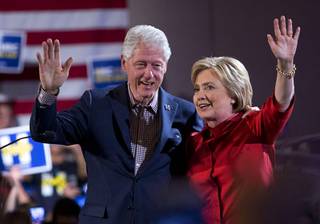
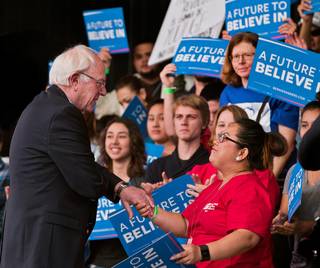
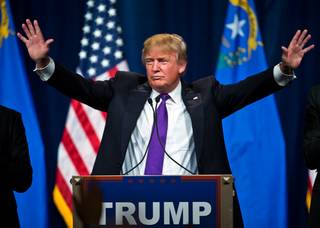
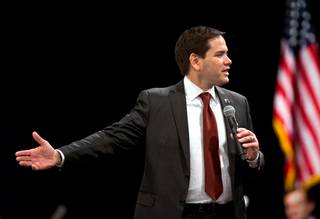
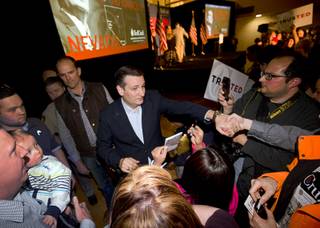

Join the Discussion:
Check this out for a full explanation of our conversion to the LiveFyre commenting system and instructions on how to sign up for an account.
Full comments policy